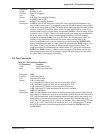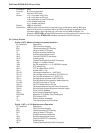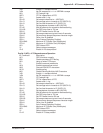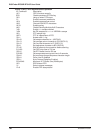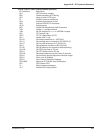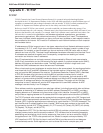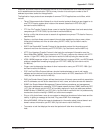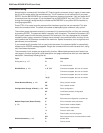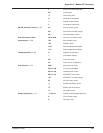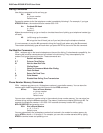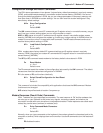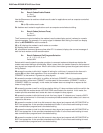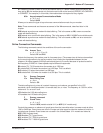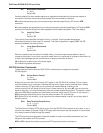
Appendix F - Modem AT Commands
RF300E/RF310E 165
Appendix F - Modem AT Commands
ISIHP modems are controlled by instructions called AT commands, so called because the attention
characters, AT, precede each command or sequence of commands (known as a command string).
You can send commands to the modem from your keyboard while in terminal mode, or you can use
communications software to issue these commands automatically.
The modem is in command mode when it is not dialing or online. When it is in command mode, you
have access to a complete communications system that allows you to use several features, including
the basic AT command set described in this chapter. Using the basic AT command set, you can enter
phone numbers for automatic dialing, configure modem options, and monitor telephone activity. In
addition, you can command your modem to perform advanced features such as error correction, data
compression, speed conversion, and more.
This chapter describes the modem’s operational modes and shows you how to use each modem AT
commands. These commands and responses are compatible with all systems and with all data
communications software using the AT command set.
Modes of Operation
The modem operates in two basic functional modes: command mode and online mode. (There is also
an in-between state, wait-for-carrier, in which the modem is out of command mode but not yet online.)
When you turn on the modem, it is in command mode and is ready to accept and respond to
commands from your keyboard or software.
The modem enters online mode after it dials, connects with another modem, and detects a valid
carrier signal. If it does not detect a carrier signal within the time frame controlled by the S-register
S7, the modem abandons the call and reenters command mode.
You can make the modem enter online mode without dialing by entering AT and then D (dial) or A
(force answer mode). The modem exits online mode if the carrier signal is lost or intentionally
dropped. When this happens, the modem hangs up and reenters command mode. By sending certain
escape characters to the modem while online, you can make it enter command mode without losing
the carrier signal. While waiting to establish the carrier, you can type any character from the keyboard
to make the modem to go back to the command mode.
Command Structure
You can control a wide variety of modem operations and options when the modem is in command
mode. AT commands tell the modem to dial a number, to answer a call, to operate at a certain speed,
to use a certain compression technique, and many other functions. AT commands consist of one or
two letters, which may be preceded by an ampersand (&), a percent character (%), or a slash
character (/). The Q command, for example, determines whether the modem returns result codes,
while the &Q command selects the asynchronous communications mode.
A parameter after a command (0, 1, 2, etc.) tells the modem which option to use. If you do not specify
a parameter, the modem assumes the 0 (zero) option. E, for example, is the same as E0. You can
issue several commands on a single line (a command string) as long as the line does not exceed 40
characters.
Note: Each character in a command counts toward the 40 character command line maximum.
Example: Q1 is a single command, but it counts as two characters in the command line.
Each command has a valid range of parameters. For example, &S can have only 0 or 1 as a
parameter. Valid commands always generate an OK result code, and a few generate an additional
response such as a list of parameters. An invalid command such as &S3, which has a parameter
outside the valid range, generates an ERROR result code. Most commands have a default parameter
that is enabled when the modem is turned on or reset with the ATZ or AT&F command. Factory
defaults are stored in read-only memory (ROM) and cannot be changed. User-defined defaults can
be stored in nonvolatile random-access memory (NVRAM) and can be changed or deleted at will.



